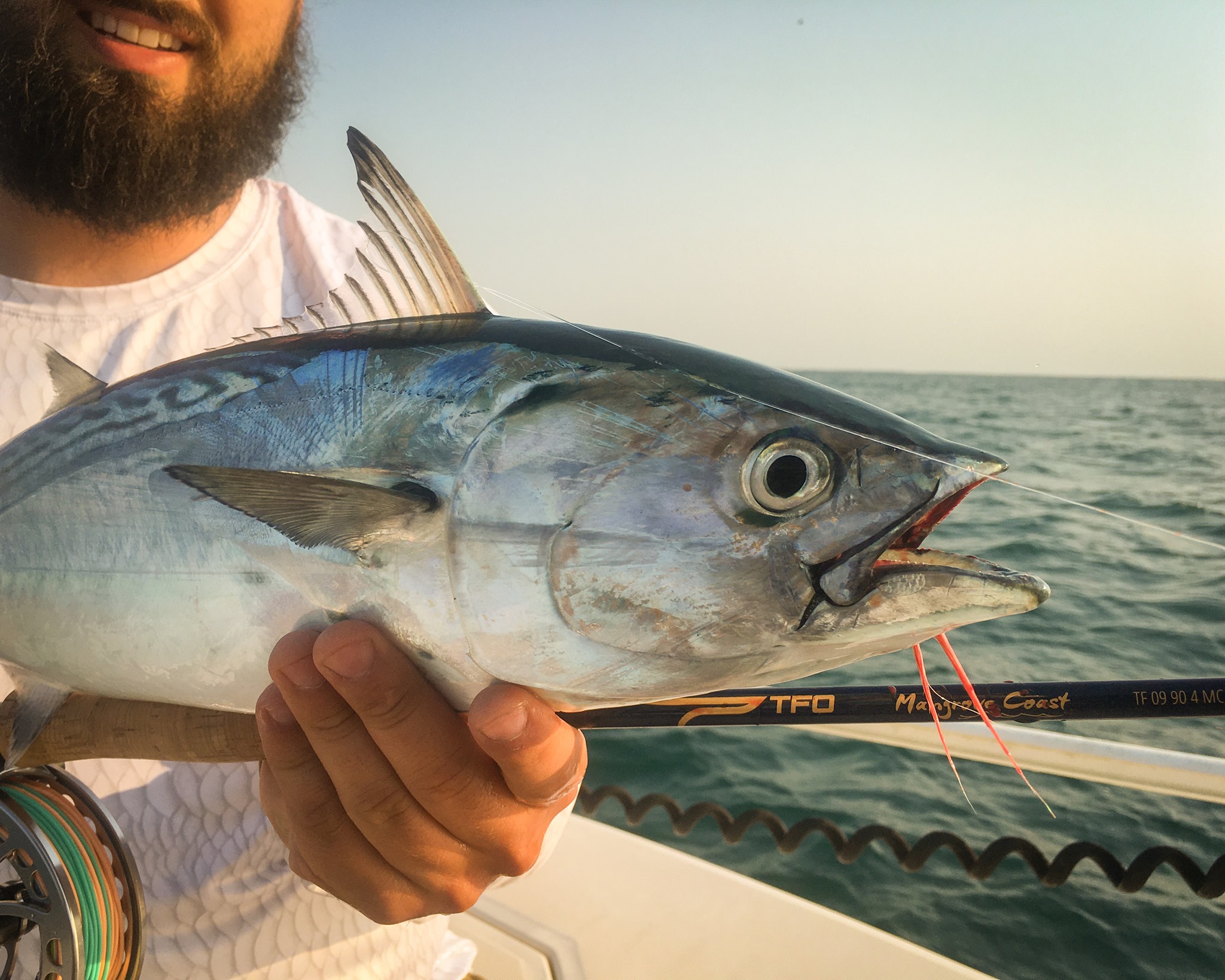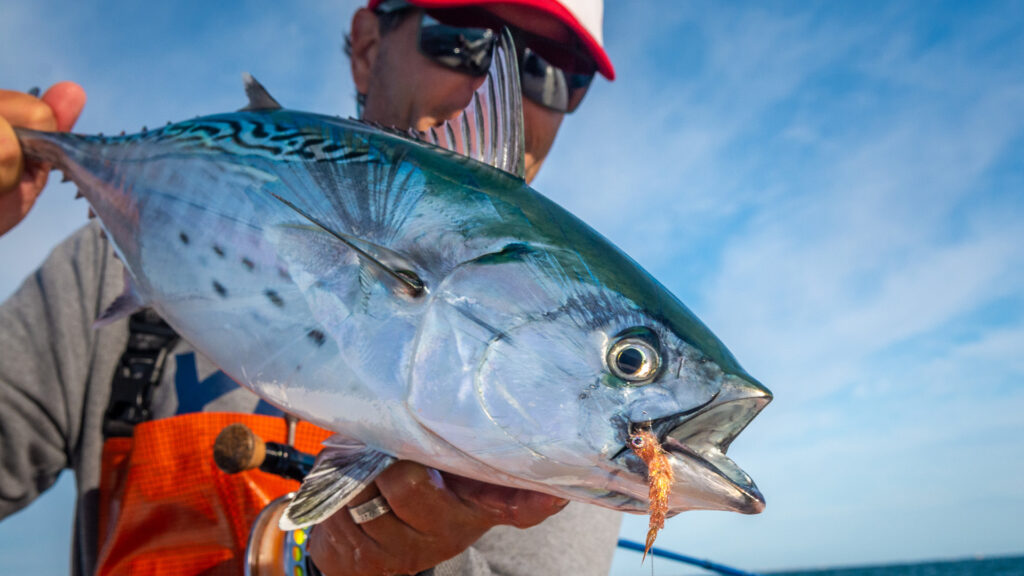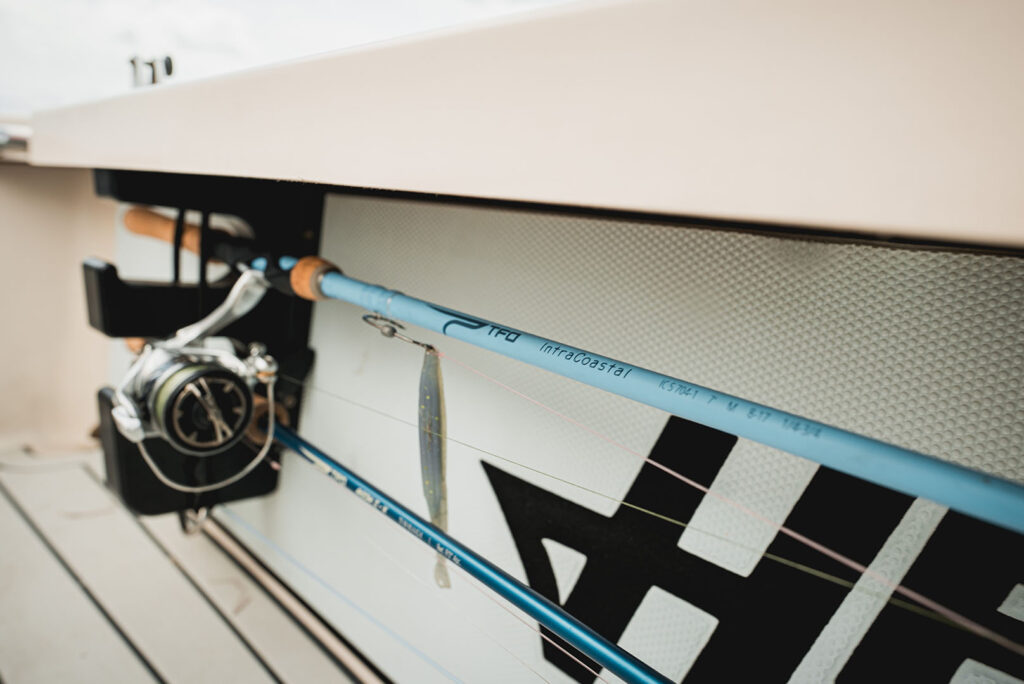I can’t remember the last day that passed without hearing someone talk about “the new normal”. With the way the world has changed, I grow increasingly fond of things that haven’t. The plain old normal: the way I feel when my wife smiles, the taste of tacos, the smell of salt air, the sound of screaming drags on fly reels, Albies…ALBIES! ALBIES!!!
On the Crystal Coast of North Carolina, fall has always meant albie season. Although found other times of year, fall brings a temperature change that sends massive bait schools from the sounds, marshes, and estuaries out to sea, bringing swarms of hungry false albacore in from the Gulf Stream to the near shore waters surrounding Cape Lookout. It is an angler’s paradise, and droves of fishermen with long rods descend on the area to enjoy the fishery.

Nathan Rhea with an albie.
False Albacore (Euthynnus alletteratus) are called many things: Albies, Little Tunny, Fat Alberts, Bonita, and Spotted Bonito to name a few. Regardless of your chosen moniker, they are pound for pound one of the strongest game fish a fly angler can hook. Lacking swim bladders, they must remain constantly in motion. This perpetual activity results in a fish capable of swimming 40 mph, and that means blistering runs when they take a fly. Albies in the 10 to 15 pound range are common, and 20 pound class fish, locally referred to as buffalos, are often caught in North Carolina waters.

Seagulls swarming over albies.
Albies hunt together like a pack of wolves. Pods of fish crash through bait balls, chomping away. It is a scene of utter carnage. Seabirds dive to the surface, picking at leftovers as the water boils beneath them. Approaching and often casting into the birds, their calls all but drown out the sound of the boat motor. The water’s surface bulges as blue-green and silver flashes rise to the surface through the bait. Careful not to put the fish down, a good captain will slow the boat down within casting range of the angler at the ready. Line piled on the deck, fly dangling in hand or trailing in the water, a well-placed cast into the ruckus can result in an immediate hook up. In the words of my dear friend John Snipes, “Get it in the gunk!”
Many anglers associate fly fishing with peaceful serenity. Albie fishing is anything but that. Whether approaching bait under gulls, or pulling behind a shrimp trawler, the atmosphere is charged. Fish are racing through the water, often disappearing as quickly as they appear. Birds are swarming, sometimes snatching your fly and creating an altogether different angling experience as they fly off with your line. Sharks enter the picture, chasing the albies. (Note: It’s always a good idea to have a nice hefty rod rigged with a steel leader and large fly. The TFO Baby Bluewater is a good option, but a nice 12 weight of your choice will do. Trust me. It helps a lot with the ensuing tug of war after hooking a 100 pound or better black tip!) Your heart will be racing, your hands will be shaking, and that’s before you even cast. Then the real fun begins as over a 100 yards of backing gets ripped from your reel as the first, of what will be several, runs begins!

The gunk!
Fishing for albies in the Cape Lookout area is most frequently done in boats. There are times when they are close enough to shore for kayak and beach anglers to reach them, but they move so quickly and often that the speed of a motorized vessel is preferred. The fish are moving, and from day-to-day can be active along different parts of the coast. For those without access to a boat, there are numerous guides in the area that specialize in the fishery including TFO Advisory Staff members Captain Jake Jordan and Captain Gary Dubiel. If you’re going to book a guide, do it as early as possible – their schedules fill quickly!
When you come, and you should come, you’ll want to have the right tools. The Cape Lookout/Harkers Island area has been called the place “where 10 weights go to die.” ~ Raiford Trask – The Saltwater Sportsman (Oct 3, 2001). 8 and 10 weight rods with floating lines are the norm. Having a sinking line on hand is never a bad idea either. I prefer moderate-fast to fast action rods that can deliver the energy necessary for long casts and the tracking and recovery required for accuracy at distance. Being able to load and unload quickly with good presentation is critical, and the TFO Axiom II X and Mangrove Coast rods deliver when it counts. Machined aluminum reels with a powerful, reliable drag are a must. Remember, you’ll be fighting powerful saltwater fish, so having enough spool for your line and 250 yards of backing is a good place to start. I like the TFO Power II or III reels, but whatever you choose needs to be sturdy and reliable.

Albie flies at the ready
Fly selection is important. Fly selection isn’t critical. What!? Yeah, that’s kind of how it goes with these guys. Some days they’re keyed in on one color and size, and nothing else will do. On other days, you could probably throw a Wooly Bugger in there and they’d eat it. You just never know, so I recommend bringing a variety. My dear friend and mentor, Rick Pope, is fond of saying, “Too much is the right amount!” My fly boxes resemble that approach, at least at the beginning of the season. During the fall, you may encounter fish feeding on Bay Anchovies (or brown bait), silversides, or spearing just to name a few. There are also tiny, clear, slender minnows with black eyes referred to as snot bait. Bottom line, there’s a whole lot of bait out there during the fall and fortune favors the prepared.
Baitfish patterns are the key, and I recommend a variety of sizes and colors. Lefty’s Deceivers, Surf Candies, Game Changers, Clouser Deep Minnows, and just about any other baitfish pattern will work. Tie or buy patterns ranging from size 6 to 1/0, or smaller and bigger if you’d like, in numerous colors. All white, tan over white, pink over white, brown over white, chartreuse over white, pink over chartreuse (Ahhh! The tuity fruity!), olive over white, and even brown over pink over white are all good choices. With flash and without flash, 1/2 an inch to 5 inches, weighted and unweighted…I think you have the idea by now. The flies don’t have to be fancy, they just need to look like baitfish and try to be ready for anything.

The author fighting an albie with a TFO Axiom II and Power II.
Besides the powerful runs, excitement of the hunt, and fish that are willing to eat, is the camaraderie of the anglers. Upon experiencing the fishery, many anglers return year after year to enjoy the albies and time with their friends. Built on the communion of albie anglers, and the area’s deep military roots, the TFO sponsored Cape Lookout Albacore and Redfish Festival was born. The 3-day event is a fishing tournament and day on the water for disabled veterans. Local captains, businesses, and citizens converge on Atlantic Beach, NC to raise funds for Project Healing Waters Fly Fishing, Inc. and to take their participants fishing for these glorious fish. Around 50 disabled veterans are provided an opportunity for a full day on the water, followed by a captains’ party, silent auction, and tournament. Although the pandemic has postponed the tournament until 2022, it’s a great time in support of a worthy cause that was featured in an episode of the Outdoor Channel’s “The Seahunter” with Captain, and TFO Advisory Staff member, Rob Fordyce.
So, what are you waiting for? It’s time. Right now! The albies are here and they’re willing to eat. Hotels are open. Restaurants are serving. Hitch up your boat and try for yourself. Book a guide. The gulls are singing and reels are screaming. What do you have to lose? It’s almost like the albies didn’t even know life wasn’t back to the good, old normal.

Blog written by TFO Ambassador Chris Thompson. Chris has been a TFO Ambassador since 2008. He is retired Marine, Chairman of the Cape Lookout Albacore and Redfish Festival, and Program Lead for the Camp Lejeune Program of Project Healing Waters Fly Fishing, Inc. He is also a self-professed albie addict.
![]()






